Mar 8, 2009 | awards, medals
I had written about NBC Nightly News anchor Brian Williams and his collection of challenge coins. In short, challenge coins are medals that bears an organization’s logo or emblem that are carried by the members and given to outsiders as an honor. When a member draws his or her challenge coin and slaps it on the table, others must produce their challenge coin or buy a round of drinks for the group. It is very popular in the military.
The company I work for has an excellent relationship with the military and other federal agencies. Aside from our business, we have many employees and board members who are retired military officers. What makes us different from an ordinary Beltway bandit firm is that the company is a non-profit that runs three (soon to be four) Federally Funded Research and Development Centers (FFRDC). In short, an FFRDC “is a unique organization that assists the United States government with scientific research and analysis, development and acquisition, and/or systems engineering and integration. FFRDCs address long-term problems of considerable complexity, analyze technical questions with a high degree of objectivity, and provide creative and cost-effective solutions to government problems.” Our non-profit status gives us the freedom to make the right decisions without conflicts of interests getting in the way.
There is a tradition similar to challenge coins in my company. When a large project successfully ends, project members are awarded with a medal representing the project. Medals are either mounted on a plaque or framed in a coaster form. While most people do not use it as a coaster I was told that there was a time that team members would use the coasters during the celebration of their accomplishment.
I have seen a few project medals given to co-workers. Most of these co-workers have been employed by the company longer than I have and were given the medals for projects that ended before I started working for the company. Many have more than one. Although I had worked on a few large projects I never received one… until now!
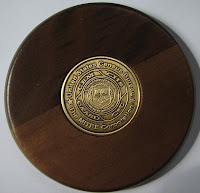 As I was leaving early on Friday a co-worker stopped me at my office door. She told me the project director was giving this to all team members handed me my first project medal. After not seeing one awarded in nearly eight years, I was very surprised. I stammered out a thank you and stopped to look at the medal.
As I was leaving early on Friday a co-worker stopped me at my office door. She told me the project director was giving this to all team members handed me my first project medal. After not seeing one awarded in nearly eight years, I was very surprised. I stammered out a thank you and stopped to look at the medal.
Within the wood coaster is a 38 millimeter bronze medal that has the name of the company and the agency that benefited from our work around the outer edge. The inner ring has the initials of the centers that had members participating in the project. In the middle is the logo of the government agency.
It is very satisfying to be a member of a significant, successful project. It is also great that one of the rewards is numismatically satisfying!
Feb 18, 2009 | CFA, medals
Anyone interested in attending the U.S. Commission of Fine Arts (CFA) meeting on February 19, 2009, can attend the 10:00 AM meeting at the National Building Museum, Suite 312, 401 F Street, NW., Washington, DC 20001-2728. CFA meetings are open to the public, but the public does not participate in the discussions.
The CFA is part of the sausage making process coin and medal designs must go through before they are struck.
On the agenda for this meeting are the final design decisions on the Congressional Gold Medals for Edward William Brooke III and Daw Aung San Suu Kyi. Design decisions will be for a gold medal and bronze duplicates.
Dec 4, 2008 | errors, history, medals
The University of Georgia is the nation’s oldest land grant university. The Georgia legislature approved the land grant measure in 1784 and the college was chartered in 1785. The first Board of Trustees meeting was held in 1786 and elected Abraham Baldwin as the college’s first president. Baldwin, originally from Connecticut, was a Yale graduate who moved to Georgia in 1784 and was asked to help draft the school’s original charter.
When the Board of Trustees decided to open the university in 1801, they selected a site. John Milledge purchased 633 acres of land in northeast Georgia and donated it to the Board of Trustees. Part of the land was developed into the town of Athens, the rest is still owned by the University.
Josiah Meigs was named president in 1801 and the Board of Trustees named the first college Franklin College in honor of Benjamin Franklin. Although the charter named the school the University of Georgia, it was known as Franklin College until 1859 when the College of Agriculture and Environmental Sciences was founded. Meigs held the first classes under a tree on what is now called North Campus. While classes were held, log buildings were hastily built as temporary structures until permanent buildings would be built.
The first permanent building was modeled after Connecticut Hall at Yale University. When it was completed in 1805, it housed classrooms, administrative offices, and dormitories. Today, that building is called Old College. Since the 1950s, it has been used as the administrative offices for the Franklin College of Arts and Sciences.
 One evening, I was searching a popular online auction site looking for something to add to my American Revolution Bicentennial collection. While searching, I found this medal for the bicentennial of my undergraduate Alma Mater (see image on right). As an alumnus of the University of Georgia, I had to buy this medal.
One evening, I was searching a popular online auction site looking for something to add to my American Revolution Bicentennial collection. While searching, I found this medal for the bicentennial of my undergraduate Alma Mater (see image on right). As an alumnus of the University of Georgia, I had to buy this medal.
Other than the subject, the medal had an interesting because of an error: the lettering on the reverse is doubled (click image to enlarge). It looks as if the dies were punched then repunched with new spacing in the lettering. While it was described in the auction listing, I had to see the medal in hand to try to understand how this error occurred. Even in-hand, it is difficult to tell. It looks as if the dies were re-punched after the letters were reset—as if someone did not like the layout and tried to change it after the dies were created.
What was not described in the auction listing was the doubling I found on the obverse. The error was very subtle and would not have been noticed by someone who was not familiar with the University of Georgia. While examining the medal, I noted that the school’s motto is on the tree’s trunk: Et docere et rerum exquirere causas (To teach, to serve, and to inquire into the nature of things).
Looking just above the motto, I saw that the “200” was doubled and above that, “To Inquire,” was also doubled. Curiosity brought out my loupe and examined the branches for the other two parts of the motto and found “To Teach” above the lower-left branch of the tree and “To Serve” above the lower-right branch. All are doubled! These are clearly re-punched into the dies.
Aside from the subject, the “errors” are fascinating. It is like getting two collectibles in one medal.
HOW BOUT THEM DAWGS!
Aug 10, 2008 | foreign, medals, video
Although I am not a big fan of the Olympics, I can appreciate a good show. The Beijing Organizing Committee for the Olympic Games (BOCOG) put on an great show for the opening ceremonies. The committee for the London 2012 games will have its work cut out for itself after that presentation.
When we think about the Olympic games, we associate the results to the medals won by each athlete for their country. These medals are made of precious metals and awarded after the conclusion of final competition in each sport. While we do not think of the Olympic medals in a numismatic context, the BOCOG chose a design for these medals that are also a symbol of ancient Chinese money in its design and the by the use of jade.
Jade was discovered over 7000 years ago in China. Its beauty and toughness helped earn its nickname as the “imperial gem.” Skilled artists were brought in to create works art to honor deities and the dynasties. Jade art was considered so valuable that it use was preferred vehicle for trade on the Silk Road over gold and silver.
China’s use of jade as currency dates back to its discovery and ends when the Han Dynasty (206 BCE to 9 CE) introduced bronze coinage. It was typical of the currency at that time to include a hole in the middle. The hole was to save on materials used and to aid in carrying. Typically, the hole reduced the metal content by half.
BOCOG is using the Olympics to convey that China is a modern country steeped in long tradition that defines them as a people. It was that purpose that BOCOG used to hold the first-ever public competition for the reverse design of the Olympic and Paralympics medals. The obverse of the medals are struck with the officials designs of the Olympics and Paralympics games. When reviewing the entries, the BOCOG selected a design to honor jade’s impact on early Chinese history and using the hole as a design element.
The result is a jade inlay covering half of the reverse of the medal that includes a 40 mm central hole. Within the hole is a simulated medal engraved with the logos for the respective games. BOCOG worked with the artists and engravers at the Shanghai Mint. This was a first for the Shanghai Mint since it is the facility that produces China’s circulated coins for China Banknote Printing and Mining company. Although working with the jade insert was a difficult process, the result is a beautifully executed modern interpretation of ancient Chinese culture.
One thousand of each medal were created for the games.
The use of jade and the rise in metal prices greatly increases the intrinsic value of the medal. Reports claim that the metal and jade makes the value of the medals $393. Medals issued for the 2004 Athens Games were worth $155 ($179.55 adjusting for inflation). This increase is directly attributable to the jade and the rise in copper prices in the last four years. Of course the price of gold is a big factor. Gold medals are silver plated with 6 grams of 24-karat gold.
Jade used for the medals were mined in China. The gold, silver, and copper were provided by BHP Billiton from their mines in Australia and Chile. BHP Billiton delivered the metals to the Shanghai Mint with much fanfare. BHP is based in Australia. The following video is likely a clip from an Australian news program when the metals were delivered to the Shanghai Mint on January 15, 2008:
Early in July, the Shanghai Mint presented BOCOG with the six thousand completed medals that will be awarded at the games. The South China Morning Post filed this report on July 3, 2008:
Medals for the 2008 Paralympic Games, scheduled for September 6-17 at the same venues as the able bodied Olympics, were given their own ceremony in Beijing. The following report was file by London’s CCTV 9:
When I watch, I will be cheering for the Americans participating in both games, especially the Redeem Team!
Jun 29, 2008 | coins, errors, medals
Error collecting is an interesting part of the hobby. Combined with variety collectors, those interested in finding coins that are not what the U.S. Mint intended is a specialty that requires a bit of education and persistence. Some of the errors and varieties collectors look for are doubled dies, repunched mint marks, clipped planchets, off-centered coins, off-metal coins, strike-throughs, and even differences in one set of dies from another.
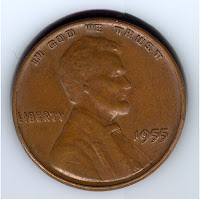 Error collecting is a relatively new specialty. The specialty can be traced to the discovery of the famous 1955 Lincoln Cent Double Obverse, now called the king of errors. Its discovery lead to people beginning to search for errors, varieties, and anything out of the ordinary.
Error collecting is a relatively new specialty. The specialty can be traced to the discovery of the famous 1955 Lincoln Cent Double Obverse, now called the king of errors. Its discovery lead to people beginning to search for errors, varieties, and anything out of the ordinary.
As a result, two organizations were formed to serve various collectors. After two decades of competition, they joined forces to create the Combined Organizations of Numismatic Error Collectors of America (CONECA). CONECA now provides education services, publications, and attribution services. Its membership are responsible for some of the definitive guides to errors, including the Cherrypicker’s Guide to Rare Die Varieties by J.T. Stanton and Bill Fivaz.
 This year marks the 25th Anniversary of CONECA. To commemorate this milestone, CONECA has created a medal that will be produced in silver, silver clad, and bronze. What makes these medals special is that CONECA will be offering various “error” versions of the medals. The five variety of errors will include an off-center and various form of double strikes. You can also buy a medal that does not simulate an error.
This year marks the 25th Anniversary of CONECA. To commemorate this milestone, CONECA has created a medal that will be produced in silver, silver clad, and bronze. What makes these medals special is that CONECA will be offering various “error” versions of the medals. The five variety of errors will include an off-center and various form of double strikes. You can also buy a medal that does not simulate an error.
For ordering information, see the CONECA website. When you get there, search for “25th Anniversary Medals Program” to see the medals and ordering information.
Whomever thought of creating errors from the commemorative medal deserves a pat on the back. It is a wonderful idea!
Medal images courtesy of CONECA.
May 24, 2008 | history, medals
On May 24, 1883, thousands of people crowded lower Manhattan and Brooklyn for the grandest of all ceremonies from all over the area—even as far away as Philadelphia. Dignitaries gathered at the armory of the Seventh Regiment on Park Avenue to board carriages to join a colour guard, a 70-piece band, and a 22-piece drum corp for the festivities. Forty mounted police officers accompanied the parade.
The list of dignitaries was a Who’s Who of the political America that included President Chester A. Arthur, New York Governor Grover Cleveland, and New York City Mayor Franklin Edson. The carriage carrying President Arthur and Mayor Edson lead the parade surrounded by a very large cheering crowd.
 At 1:50 PM, the processional arrived at the entrance of the new bridge, President Arthur and Mayor Edson left their carriage and crossed what was the world’s longest suspension bridge arm-in-arm to a cheering crowd who paid $2 for tickets to watch from the bridge.
At 1:50 PM, the processional arrived at the entrance of the new bridge, President Arthur and Mayor Edson left their carriage and crossed what was the world’s longest suspension bridge arm-in-arm to a cheering crowd who paid $2 for tickets to watch from the bridge.
The band played Hail to the Chief as ships who came to the ceremony and anchored around the East River blew horns to honor the President. Navy ships who were invited to the ceremonies took turns giving 21-gun salutes.
 Present Arthur and Mayor Edson were joined by Brooklyn Mayor Seth Low when they arrived on the other side of the new bridge. The three men locked arms and marched to the Brooklyn Pier to complete the ceremony dedicating the Brooklyn Bridge to the people of the New York City and Brooklyn.
Present Arthur and Mayor Edson were joined by Brooklyn Mayor Seth Low when they arrived on the other side of the new bridge. The three men locked arms and marched to the Brooklyn Pier to complete the ceremony dedicating the Brooklyn Bridge to the people of the New York City and Brooklyn.
Kickoff for the Brooklyn Bridge 125th Anniversary Celebration began on May 22 with a concert by the Brooklyn Philharmonic and fireworks by the Gruccis, the first family of fireworks. The celebration extends through Monday that includes a walking tour of this impressive structure on Saturday, the anniversary.
 In honor of the 125th Birthday of the bridge everyone owns, the image to the right is a bronze medal commemorating her Centennial (click to enlarge). This medal was produced by the Medallic Arts Company for Brooklyn Union Gas. Silver medals were made for the company’s executives. Bronze medals were given to some employees and offered for sale to the public. When the company that owns Brooklyn Union Gas merged with the Long Island Lighting Company (LILCo) in 1998, the company changed its name to KeySpan Energy. In 2007, KeySpan was bought by National Grid plc of London.
In honor of the 125th Birthday of the bridge everyone owns, the image to the right is a bronze medal commemorating her Centennial (click to enlarge). This medal was produced by the Medallic Arts Company for Brooklyn Union Gas. Silver medals were made for the company’s executives. Bronze medals were given to some employees and offered for sale to the public. When the company that owns Brooklyn Union Gas merged with the Long Island Lighting Company (LILCo) in 1998, the company changed its name to KeySpan Energy. In 2007, KeySpan was bought by National Grid plc of London.
By the way… I have a bridge I can sell to you. Let me know and I can give you a good deal!
Source: “Two Great Cities United,” [PDF] The New York Times, May 25, 1883.
May 9, 2008 | commemorative, legislative, medals
On Tuesday, the White House announced that President George W. Bush signed H.R. 4286 to award the Congressional Gold Medal to Daw Aung San Suu Kyi, Burma’s prime minister-elect who has been under house arrest for the past six years. The enrolled bill was sent to the President on May 1, President Bush singed the bill after the recent natural disaster in the country now called Myanmar and the problems with trying to get aid to the people posed by the current military government.
Aung San Suu Kyi is the 1991 Nobel Peace Prize recipient for her work on behalf of the Burmese people. When award the $1.3 million prize, Ms. Suu Kyi used the money to establish a health and education fund for Burma. She is the only Nobel Peace Prize winner imprisoned. Congress will present her with the gold medal to recognize her commitment to peace, nonviolence, human rights and democracy in Burma.
H.R. 4286 call for the Secretary of the Treasury to “shall strike a gold medal with suitable emblems, devices, and inscriptions.” The Secretary can also strike duplicate bronze and gold medals for sale to the public at a price to be determine. Proceeds from the sale of duplicate medals will be deposited in the US Mint Public Enterprise Fund.
May 8, 2008 | history, medals, US Mint
Harry S Truman became the 33rd President of the United States following the death of Franklin D. Roosevelt in 1945, a few months into Roosevelt’ fourth term. Truman presided over the end of the World War II in Europe and the decisive victory over Japan. He also oversaw the signing of the first United Nations charter.
Controversy followed Truman through his presidency which the close election in 1948 against Thomas E. Dewey. Amongst Truman’s controversial accomplishments was helping establish the North Atlantic Treaty Organization (NATO) and the integration of the armed forces. History has been kinder to Truman than were his critics during the 1952 election.
Harry S Truman was born on May 8, 1884 in Lamar, Missouri making today his 124th birthday. In celebration of Truman’s birthday, the US Mint sent out a release noting that they sell a 15/16-inch bronze medal honoring Truman’s inaugurations. The medal was design by John R. Sinnock (obverse) and Gilroy Roberts (reverse) was struck at the Philadelphia Mint.
Happy Birthday and give ’em hell, Harry!
Mar 29, 2008 | fun, medals
In the movie 300, Leonidas lead 300 of the best Spartan soldiers to prevail over the more powerful Persian army. In sports, 300 is a perfect bowling score where the bowler has thrown twelve straight strikes. The Chrysler 300 is a car model and the face value of the Rocky Mountain Panoramic Photography Commemorative coin is 300 Canadian dollars.
You may ask, “what is this obsession with the number 300?”
This posting marks my 300th posting to the Coin Collector’s Blog.
Three hundred times, I have written, mused, and ranted something about coins. Weather it be about my own collecting pursuits, news, opinions, or an occasional review, I have used this forum to entertain and inform. I thank everyone for reading.
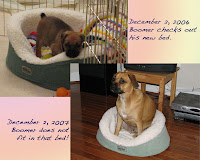 So that this post is not totally self-ingratiating, I do want to go back to an earlier post and provide an update. On December 3, 2006, I wrote about a new acquisition that was not exactly numismatic-related. His name is Boomer, our cute little puggle. At time we brought him home, he was a nine week old bundle. Today, Boomer is 45 pounds of adolescence with the appetite of a Pug and the nose of a Beagle. He is a fun dog with a playful personality who continues to give us joy each day.
So that this post is not totally self-ingratiating, I do want to go back to an earlier post and provide an update. On December 3, 2006, I wrote about a new acquisition that was not exactly numismatic-related. His name is Boomer, our cute little puggle. At time we brought him home, he was a nine week old bundle. Today, Boomer is 45 pounds of adolescence with the appetite of a Pug and the nose of a Beagle. He is a fun dog with a playful personality who continues to give us joy each day.
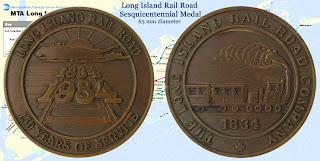 To end this posting with something numismatic, I found an image of a collectible I never posted here. It is a 63 millimeter bronze medal honoring the sesquicentennial (150 years) of the Long Island Railroad. For anyone who has spent any time on Long Island, the LIRR is an important part of the life and culture. Its lines concentrate in Jamaica, Queens where Long Islanders would be dispatched into areas of New York City to the west and home to Long Island toward the east. I purchased this medal a year ago for a nice price since there is a rim ding on the reverse between the “N” and “G” in the word “Long.” Since this minor imperfection does not detract from the medal’s beauty, it was a perfect addition to my New York collection!
To end this posting with something numismatic, I found an image of a collectible I never posted here. It is a 63 millimeter bronze medal honoring the sesquicentennial (150 years) of the Long Island Railroad. For anyone who has spent any time on Long Island, the LIRR is an important part of the life and culture. Its lines concentrate in Jamaica, Queens where Long Islanders would be dispatched into areas of New York City to the west and home to Long Island toward the east. I purchased this medal a year ago for a nice price since there is a rim ding on the reverse between the “N” and “G” in the word “Long.” Since this minor imperfection does not detract from the medal’s beauty, it was a perfect addition to my New York collection!
Happy collecting!
Feb 17, 2008 | ANA, Baltimore, bicentennial, medals
With the Baltimore Coin and Currency Convention coming at the end of the month, I realized I did not talk about the last show I attended. That show was a while ago and would not be interesting now. What is interesting is one of the items I found while walking the bourse floor.
Whenever I go to a coin show, I look for something “neat.” Something different that was not expensive but would raise an eyebrow or two when I show the item to others. Last summer, I found an 1803 Large Cent with a barely readable date. There was also the GSA Softpack I picked up at the ANA National Money Show in Charlotte.
Before attending to the last Baltimore show, I decided that I would concentrate on my 1976 collection and look for numismatic-related items. With that in mind, I was walking the bourse floor looking at the various tables and found a set of medals in a plastic holder. The blue set caught my eye when I focused in and saw that the set was from 1976.
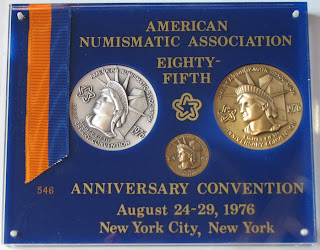 I stepped up to the table to take a closer look and found that it is the 1976 ANA Convention Medal Set. Back when the ANA held one convention per year, this set consists of pewter, bronze, and copper medals showing the image of the a bust of the Statue of Liberty in front of United Nations building. The medals for the 85th Anniversary convention also featured the star logo of the American Revolution Bicentennial Association (ARBA) and are stored in a custom case made by Capital Plastics.
I stepped up to the table to take a closer look and found that it is the 1976 ANA Convention Medal Set. Back when the ANA held one convention per year, this set consists of pewter, bronze, and copper medals showing the image of the a bust of the Statue of Liberty in front of United Nations building. The medals for the 85th Anniversary convention also featured the star logo of the American Revolution Bicentennial Association (ARBA) and are stored in a custom case made by Capital Plastics.
This set registered high on the “oh, neat” meter. It was from 1976, had the ARBA logo, and would also fit in my New York collection. When the dealer said he is selling the set for $15, I did not hesitate to reach in my pocket for the money. As I learned more about the set, some collectors were offering four-to-five times the price I paid. The set is not for sale, but it is nice to know that I cherry picked a nice item.
I can only wonder what I will find at the end of this month. Stay tuned!
 As I was leaving early on Friday a co-worker stopped me at my office door. She told me the project director was giving this to all team members handed me my first project medal. After not seeing one awarded in nearly eight years, I was very surprised. I stammered out a thank you and stopped to look at the medal.
As I was leaving early on Friday a co-worker stopped me at my office door. She told me the project director was giving this to all team members handed me my first project medal. After not seeing one awarded in nearly eight years, I was very surprised. I stammered out a thank you and stopped to look at the medal.








